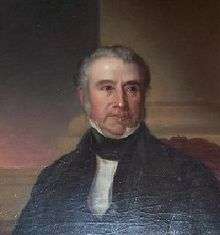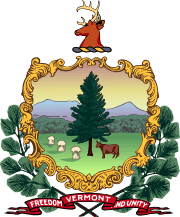Charles K. Williams
| Charles K. Williams | |
|---|---|
 | |
| 20th Governor of Vermont | |
|
In office October 11, 1850 – October 1852 | |
| Lieutenant | Robert Pierpoint |
| Preceded by | Carlos Coolidge |
| Succeeded by | Erastus Fairbanks |
| Member of the Vermont House of Representatives | |
|
In office 1809-1811 | |
| Personal details | |
| Born |
January 24, 1782 Cambridge, Massachusetts |
| Died |
March 9, 1853 (aged 71) Rutland, Vermont |
| Political party | Whig |
| Spouse(s) | Lucy Langdon |
| Profession | lawyer / politician |
| Religion | Episcopalian |
Charles Kilbourne Williams (January 24, 1782 – March 9, 1853) was an American lawyer and politician. He served as Chief Justice of the Vermont Supreme Court from 1834 to 1846 and as Governor of Vermont from 1850 to 1852.
Biography
Williams was born in Cambridge, Massachusetts, Middlesex County to Samuel Williams and Jane Kilbourne Williams. He moved with his family to Rutland, Vermont in 1790. He graduated from Williams College in 1800 and earned an M.A. jointly from Williams and Middlebury Colleges and an LL.D. from Middlebury.[1]
Williams was elected to the Vermont House of Representatives and served from 1809 to 1811. He served in the Vermont Militia as a Major during the War of 1812. He was promoted to the rank of Brigadier General and became commander of a division. He was again elected to the Vermont House of Representatives and served from 1814 to 1815, 1820 to 1821 and in 1849.[2]
He served as Rutland County State's Attorney from 1814 to 1815,[3] and as Justice of the Vermont Supreme Court from 1822 to 1824.[4] He was Vermont's US Collector of Customs from 1825 to 1829. In 1827 he was State Commissioner for common schools. He served as Chief Justice of the Vermont Supreme Court from 1834 to 1846.[5] Williams was the author of a precedent setting opinion on the unconstitutionality of legislative acts passed to nullify judicial decisions.
Williams ran unsuccessfully for Governor of Vermont in 1842 as an abolitionist candidate. He served as President of the Council of Censors in 1848. Elected as a Whig, Williams served as Governor of Vermont from 1850 to 1852.[6] While in office, the Habeas Corpus Act was passed, showing the strong anti-slavery sentiments in Vermont. He did not seek reelection as governor.
He served as a Trustee of Middlebury College[7] and as President of the Williams College Alumni Association.
Family life
Williams married Lucy Green Langdon of Castleton,[8] and they had nine children together.
Williams' was the son in law of Congressman Chauncey Langdon.[9]
Death
Williams died in Rutland on March 9, 1853, and is interred at Evergreen Cemetery in Rutland, Vermont.[10]
References
- ↑ "Vermont Governor Charles Kilborn Williams". National Governors Association. Retrieved November 2, 2012.
- ↑ "Williams, Charles Kilborn (1782-1853)". The Political Graveyard. Retrieved November 2, 2012.
- ↑ "Rutland County Selected County Officials". The Political Graveyard. Retrieved November 2, 2012.
- ↑ "Justices of the Supreme Court" (PDF). Office of the Vermont Secretary of State. Retrieved November 2, 2012.
- ↑ "The History of Rutland County". Ancestry.com. Retrieved November 2, 2012.
- ↑ "Governor of Vermont". NDDB. Retrieved November 2, 2012.
- ↑ "HISTORY OF RUTLAND COUNTY". Middlebury College. Retrieved November 2, 2012.
- ↑ "Lucy Green Langdon". Find A Grave. Retrieved November 2, 2012.
- ↑ "Langdon, Chauncey (1763-1830)". The Political Graveyard. Retrieved November 2, 2012.
- ↑ "Charles Kilbourne Williams". Find A Grave. Retrieved November 2, 2012.
External links
| Wikimedia Commons has media related to Charles K. Williams. |
- Governor of Vermont Notable Names Database
- Find A Grave
- The Political Graveyard
- National Governors Association
- The Official State Website of Vermont
- Ancestry.com: The History of Rutland County
| Political offices | ||
|---|---|---|
| Preceded by Carlos Coolidge |
Governor of Vermont 1850–1852 |
Succeeded by Erastus Fairbanks |
